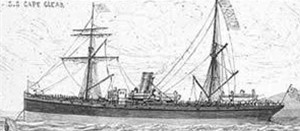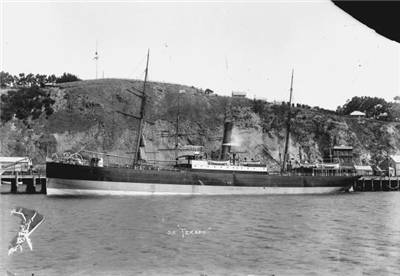
My Photos. Well some of the wreckage anyway
© Michael McFadyen
 |
| SS Cape Clear |
In November 1884 it was purchased by the Union Steam Ship Company of New Zealand for £36,500 (one source says £34,000) and renamed SS Tekapo. After the purchase the Tekapo was modifed by Denny and Brothers of Dumbarton (another small town just north of Glasgow in Scotland - a very nice little place). After the modification, the ship carried cargo as well as passengers. You can see that the photo below of the Tekapo shows some differences from the Cape Clear. These are primarily a taller and skinnier funnel and the addition of what is probably the passenger accommodation behind the bridge. The Tekapo could carry 133 passengers, 82 in Saloon Class and 51 in Steerage. In its day it was one of the bigger ships operating in the Australian region.
After purchase it appears that the Tekapo was utilised on the NZ to Australia run until October 1887 when it sailed from Lyttelton (Christchurch, NZ) for Calcutta, India. The Tekapo made two more voyages to Calcutta in June and September 1888, each time carrying about 250 horses for the British Army. On the return trip, the ship brought back thousands of bales of woolpacks and cornsacks for the New Zealand agriculture industry as well as tea and other merchandise. On the return trips she stopped at Adelaide and Melbourne. This was more profitable than the forward trip. In between these trips to the sub-continent, the Tekapo continued on the Trans Tasman run. It appears that the Tekapo was also used for some time on the Launceston to Sydney run, bringing Tasmanian produce back to Sydney and also on the Sydney to the South Seas run.
 |
| SS Tekapo at Port Chalmers in NZ |
In mid-1894 the ship would appear to have been still being used on the Australian/New Zealand to India run as on 10 May 1894 she arrived in Albany, Perth after travelling from Adelaide, South Australia.
The Tekapo arrived in Sydney Harbour from Launceston on 13 May 1899. At 2.30 am on Tuesday 16 May 1899 the Tekapo left Sydney Harbour under the command of Captain Herbert Sams for Port Kembla (just south of Sydney) where it was to take on coal to replenish its bunkers before returning to Sydney for another trip to New Zealand. Fog settled over the coast and the course set should have let the ship sail safely to Port Kembla. The fog got worse (why is it that having lived almost all my life in the Eastern Suburbs, I have never once seen fog that even went a dozen metres off the coast??) so Captain Sams kept to half speed. Crew were stationed forward as lookouts. It is stated that the fog was so bad the bridge could not even see the foremast. Why the Captain did not hove to in such conditions is one of those questions that will never be known.
The Tekapo did not get far, only 14 kilometres from Sydney Harbour, when she came to grief on the southern headland of Maroubra Beach. The vessel bumped twice amidships and lifted onto flat rocks off the main rock platform. The bow smashed heavily against a wall of rock. The time was 3.45 am.
A check of the engine room showed no water so Captain Sams ordered the ship to be placed in full reverse. Nothing happened. Rockets and distress guns were fired but South Head lighthouse saw and heard nothing. Residents of Randwick, Coogee, Rockdale and along the Cooks River heard the signals (obviously considering the fog, they saw nothing) and reported it to the authorities. Captain Sams then ordered the lifeboats to be launched as the fog prevented the crew from seeing that they were actually right on the shore.
The first boat ran onto rocks almost straight away. It took two hours for the ship to be located and the boat under the command of Second Officer, Mr Fisk, did not reach the Coogee Bay Hotel until 7am (Maroubra was still not settled). At 9 am the pilot vessel Captain Cook and the tug Vigilant started on their way to Maroubra Beach. Together with the tugs Fearless, Newborough and Greyhound were not able to move the ship an inch.
Plates were opened up by hitting the rocks and water was in the forward hold. The swells were moving the wreck, lifting her up and dropping her on the rocks. Three tugs remained on location but stood out to sea during the night of 16 May 1899. By the next morning the vessel was further up the platform. Divers reported that the hull was holed in the ballast tanks and bow. Meanwhile, salvage work went on and everything possible was removed and put on the tugs.
As attempts to refloat the Tekapo failed, the Union Steamship Co. submitted the hulk to the insurance company. Salvage went on till Friday 19 May when the hull was sold for £380, to, of all people, the Union Steamship Co. The seas had been very calm since the 17 May 1899 and the ship had not suffered any more damage so it was still thought possible to refloat the ship.
On Monday 22 May 1899, the seas picked up dramatically and the Tekapo was hit by the swells. However, little additional damage was caused. The Union Steamship Co. had by now sold the wreck to Mr Mountenay (who had also purchased the Hereward just year and a few days earlier - located less than 2000 metres to the north on North Maroubra Beach). His intention was to take the wreck apart piece by piece.
Wednesday 24 May 1899 was the Queen's Birthday Holiday and the residents of Sydney came in their tens of thousands to see the wreck. This was a forerunner of activities to come just over 30 years later when hundreds of thousands trekked out to Malabar and La Perouse to see the wrecks of MV Malabar and SS Minmi respectively. The people caught trams to Coogee and either walked or came by coach and bike to the southern end of Maroubra Beach. Some people walked nine miles from the city along Bunnerong Road.
The last report of the Tekapo wreck was on 31 May 1899 when it was reported that the ship had broken into three pieces but "There is...a prospect of good salvage". The engine, dynamo and fittings were apparently removed.
As usual, a Marine Board of Inquiry was held and on 12 June 1899 it found that the wrecking of the Tekapo was caused by the wrongful act or default of Captain Herbert Sams by navigating too close to the shore and setting a course that set the ship on shore during fog. Captain Sams' Foreign Going Masters Certificate was suspended for six months from the date of the wreck.
On 22 June 1986, the anchor of the Tekapo was raised by Maroubra diver Greg Tannos and some other divers and taken to Rose Bay by boat. The anchor was then treated and it now stands adjacent to the Maroubra Surf Life Saving Club.
To date I have not found any part of the wreck that would confirm it as coming from the Tekapo. There is some wreckage about 200 metres out from the sand of South Maroubra Beach in five metres of water. This could be from the Tekapo or from the SS Belbowrie which was wrecked not too far away on 16 January 1939. The wreckage here includes some bollards, iron or steel plates (possibly confirming this as the Tekapo as the Belbowrie was a timber vessel) as well as a smallish winch.
I have also searched out towards the far point (Magic Point) using a scooter but have not found a single piece of wreckage. Considering the size of the Tekapo, there must be a considerable amount of the wreck somewhere here as the boiler and prop would not have rusted away. As mentioned above, the engine was reported to have been salvaged in 1899.
If anyone has any more information on the exact location of the main part of the wreck, I would be happy to hear from them.
References:
Note:
All photographs can be found in the NSW Library, Mitchell Section.